Abstract
In response to the suboptimal electrochemical performance of low-valence vanadium oxides, Ganoderma lucidum biomass-derived carbon@V2O3 (V2O3@CGL) composites were prepared by evaporative self-assembly technology and high-temperature calcination. In the prepared composites, V2O3 effectively encapsulates CGL, serving as a support for V2O3 and enhancing electrical conductivity and structural stability. This results in improved overall performance for the composites. They revealed satisfactory electrochemical properties when assembled in aqueous zinc-ion batteries (AZIBs). The preliminary discharge specific capacity of the V2O3@CGL-2 (VOCG-2) composite electrode reached 407.87 mAh g−1 at 0.05 A g−1. After 1000 cycles, the capacity retention is 93.69% at 3 A g−1. This research underscores the feasibility of employing V2O3 and abundantly available biomass for high-performance AZIB cathodes.
1. Introduction
Severe environmental pollution and energy shortages have compelled us to develop inexpensive and renewable storage devices for energy [1,2]. Lithium-ion batteries, as a type of secondary battery, are currently one of the most widely used energy storage devices on account of their satisfactory energy density and long cycle life [3,4]. Nonetheless, concerns about safety and limited resources, such as lithium metal, have driven the exploration of new battery systems. In recent years, water-based metal-ion batteries (e.g., zinc, sodium, potassium, magnesium, and calcium) have shown enormous possibilities in energy storage, considering the abundant reserves of metal resources on earth and their inherent safety [5].
Among these options, AZIBs have garnered significant curiosity from researchers worldwide because of their rich sources, non-toxicity, high safety, low REDOX potential (−0.76 V), and excellent theoretical capacity (approximately 820 mAh g−1) [6,7,8,9]. However, research on AZIBs is still in its early stages, and it is challenging to find positive electrode materials suitable for reversible Zn2+ embedding or de-embedding, restricting the development of AZIB systems. Previous studies on AZIB cathode materials have focused on Prussian blue analogues with a cubic open frame structure [10]. However, this has a limited capacity (about 60 mAh g−1), which hinders further development. Manganese oxides, such as MnO2, α-Mn2O3, and Mn3O4, have considerable voltage and desirable capacity. Nonetheless, the dissolution of manganese in the electrolyte leads to poor cycling performance [11,12,13].
Among AZIB cathode materials, vanadium-based materials have been extensively researched for their high specific capacity, vast resources, and excellent cycle stability [14,15,16,17]. For instance, Hu et al. [18] obtained porous V2O5 material (P-V2O5) by pyrolyzing V-MOF. As the cathode for AZIBs, the P-V2O5 electrode manifested a capacity of 120 mAh g−1 at 2 A g−1. They also demonstrated that the formation of V2O5 nanoflakes and the reorganization with carbon can increase cycle stability. Mai et al. [19] successfully developed Na2V6O16·1.63H2O material that is highly suitable for Zn2+ embedding and removal, demonstrating a noteworthy specific capacity of 352 mAh g−1 and a desirable long-cycle stability with a capacity retention of 90% for 6000 cycles at 0.05 A g−1.
Although well developed in small-scale production, the above synthesis methods are still far from commercialization due to their complexity, the high cost of electrolyte and electrode materials, and unsustainable carbon sources [20,21]. Therefore, the search for cheap, abundant, and renewable raw materials gradually gains popularity. Biomass, a carbon-rich precursor, has been extensively researched in various applications because of its inherent benefits, such as environmental friendliness, abundant renewable resources, and economic benefits [22,23,24].
In this study, the Ganoderma lucidum biomass was first activated using KOH ultrasonic solvent and calcination. The observed V2O3@CGL composites exhibited a large specific surface area and numerous mesopores, which furnished abundant active sites and efficient channels for reversible storage of Zn2+. Three Ganoderma lucidum biomass-derived carbon/V2O3 composites were prepared as positive electrodes for AZIBs, with the economical 3M ZnSO4 serving as the electrolyte. The VOCG-2 composite electrode displayed outstanding durability with a satisfactory capacity retention of 93.69% after 1000 cycles at 3 A g−1. SEM analysis confirmed that the VOCG-2 composite electrode maintained a steady morphology during circulation. These findings suggest VOCG-2 composites offer promising potential for fast and long-lasting storage of Zn2+.
2. Results
Through XRD investigations, detailed information regarding the crystal structure of the V2O3@CGL composites was obtained. Figure 1a illustrates the XRD patterns of the V2O3@CGL composites, displaying a broad diffraction peak at approximately 2θ = 24.5°, which is consistent with the (002) plane of amorphous carbon [25]. The peak intensity of this diffraction peak diminishes with the reduction of carbon in the composites. No additional noteworthy residual phases were detected, implying that there is no noticeable impact of CGL on the crystal structure of V2O3. In addition, the diffraction peaks centered at 65.2°, 53.9°, 41.3°, 36.3°, 33.0°, and 24.3°, correspond to the (300), (116), (113), (110), (104), and (012) diffraction planes, respectively, of the rhombic crystalline phase of V2O3 (PDF#84-0316), evidencing the successful synthesis of the V2O3 phase.
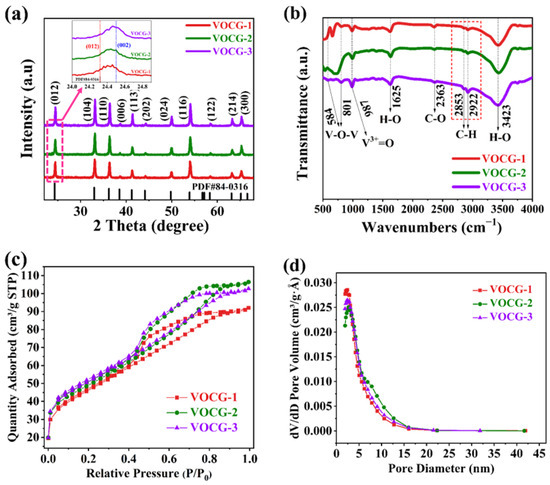
Figure 1.
(a) XRD patterns; (b) FT-IR spectrum; (c) N2 absorption/desorption isotherms; and (d) pore size distribution of the V2O3@CGL composites. Inset images show the (012) and (002) diffraction planes of the V2O3@CGL composites.
Figure 1b reveals a typical FT-IR spectrum of the V2O3@CGL composites. The peaks situated at 2853 and 2922 cm−1 denote the presence of residual C-H groups [26]. The peak observed at 2367 cm−1 corresponds to an asymmetric stretching vibration of C-O, which is attributed to CO2 adsorption on KBr and is negligible [27]. The H-O bending vibration and H-O stretching vibration can be identified at 1625 and 3423 cm−1, respectively, which may be because of certain water molecules adsorbed on the surface and embedded in the composite interlayers [28]. Furthermore, the peaks located at 801 and 584 cm−1 are ascribed to the symmetric and asymmetric stretching vibrations of the V-O-V bond [29,30,31]. The signal at 987 cm−1 is related to the symmetric stretching of V3+=O, suggesting the presence of V2O3 [32,33]. Based on the above analysis, the synthesized V2O3@CGL composites consist of V2O3 and biomass-derived carbon, which coincides with the results of the XRD.
The porosity and specific surface area of electrode materials are critical for ion diffusion. Therefore, N2 adsorption/desorption isotherm experiments were carried out. As depicted in Figure 1c,d, the three V2O3@CGL composites exhibit typical IV isotherms followed by H3-type hysteresis loops, suggesting that the materials include a significant number of mesoporous pores in the samples. The average pore diameter, pore volume, and specific surface area of the three V2O3@CGL composites are summarized in Table 1. Among them, the specific surface area of VOCG-3 composite is as high as 174.2683 cm2 g−1, which is significantly larger than VOCG-1 (154.9935 cm2 g−1) and VOCG-2 (164.5602 cm2 g−1), suggesting that with a higher content of V2O3, the specific surface area will increase. Additionally, the pore sizes of the three V2O3@CGL composites range from 2 to 43 nm (see Figure 2d). The abundant mesoporous structure and large specific surface area facilitate rapid storage of Zn2+. Furthermore, a suitable pore size distribution promotes ion diffusion, thereby enhancing the magnification performance of V2O3@CGL composites [34].

Table 1.
Pore volume, specific surface area, and average pore size of the V2O3@CGL composites.

Figure 2.
TGA curves of (a) VOCG-1, (b) VOCG-2, and (c) VOCG-3 composites.
To ascertain the weight percentage of every ingredient in the V2O3@CGL composites, a TGA test was carried out at 25–800 °C in nitrogen, as illustrated in Figure 2. The three TGA curves exhibit three distinct weightlessness stages. The first two stages occur at room temperature to about 136 °C and 400 °C, respectively, which are associated with the release of structural water and adsorbed water in the V2O3@CGL composites. The mass loss in the first two stages of VOCG-1, VOCG-2, and VOCG-3 was 6.96%, 7.31%, and 7.28%, respectively. The third stage of weightlessness occurs at about 400–580 °C, which is related to the combustion of CGL in the V2O3@CGL composites. The weightlessness in the third stage for VOCG-1, VOCG-2, and VOCG-3 composites was 18.68%, 16.18%, and 14.5%, respectively. According to the data obtained from the TGA, the mass content of CGL and V2O3 in VOCG-1, VOCG-2, and VOCG-3 was 18.68% and 74.36%, 16.18% and 76.51%, and 14.5% and 78.22%, respectively.
The surface elemental composition, electronic states, and bonding states of the V2O3@CGL composites were studied by means of XPS spectroscopy. As depicted in Figure 3a, V, O, and C elements were detected in the XPS measurement spectra. The bonding state of V, C, and O was further evaluated by the V 2p, C 1s, and O 1s peaks. As displayed in Figure 3b, the peaks are located at 288.58, 285.76, and 284.77 eV, respectively, matching the O=C-O−, C-O, and C-C bonds of C 1s, which are derived from CGL [35,36,37]. Figure 3c exhibits three contributions from the fitted O 1s peaks, with binding energies of 533.06, 531.6, and 530.33 eV, attributed to the O=C-O−, C-OH, and V-O bonds [22,38,39], respectively. The V 2p peak of the V2O3@CGL composites (Figure 3d) is decomposed into two peaks at 523.78 and 516.8 eV, corresponding to V 2p1/2 and V 2p3/2, proving the presence of V2O3 [40,41,42].
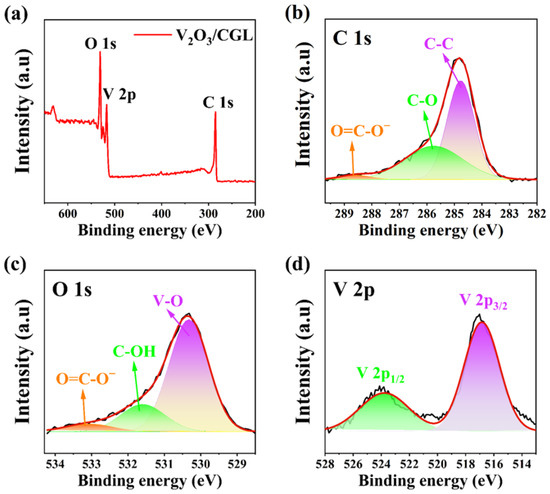
Figure 3.
(a) XPS survey spectra; at high-resolution: (b) C 1s, (c) O 1s, and (d) V 2p XPS spectra of the V2O3@CGL composites.
Figure 4 illustrates the SEM pictures of the V2O3@CGL composites. The CGL in the V2O3@CGL composites reveals an irregular three-dimensional porous structure with diameters ranging from 30 to 300 μm. V2O3 is observed to be encapsulated on the surface of the CGL or entering its pores. The surface of VOCG-1 composite is relatively smooth, with the exposed Ganoderma lucidum biomass-derived carbon visible, while the surfaces of VOCG-2 and VOCG-3 composites are relatively rough. Notably, VOCG-3 is completely covered by V2O3, with the bare Ganoderma lucidum biomass-derived carbon barely discernible. This indicates that VOCG-1 composite contains the least amount of V2O3, while VOCG-3 composite contains the greatest amount of V2O3. Furthermore, CGL can provide a carbon skeleton for V2O3, effectively overcoming the adverse effects of V2O3 aggregation and volume expansion during charging and discharging, thus enhancing the zinc storage performance [43]. Moreover, the elemental mapping of the V2O3@CGL composites is presented in Figure 5, which reveals that the C, O, and V elements are homogeneously dispersed in the V2O3@CGL composites. This, together with the XRD and XPS data presented above, provides evidence that the synthesis of the V2O3@CGL composites was successful. It is notable that a comparison of the brightness of the elemental maps of the three composites reveals that the VOCG-1 composite has the highest concentration of carbon and the lowest concentration of vanadium, while the VOCG-3 composite has the lowest concentration of carbon and the highest concentration of vanadium. This indicates that the VOCG-1 composite has the lowest vanadium pentoxide content, while the VOCG-3 composite has the highest V2O3 content.
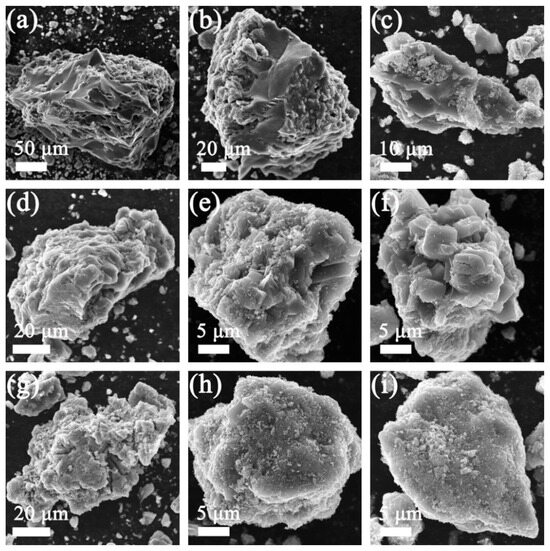
Figure 4.
SEM pictures of (a–c) VOCG-1, (d–f) VOCG-2, and (g–i) VOCG-3 composites.
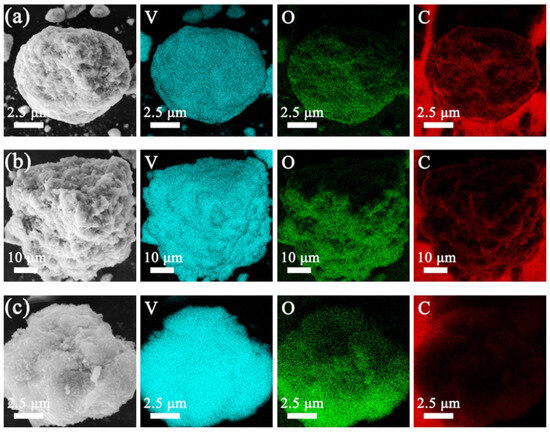
Figure 5.
SEM and elemental mapping images of (a) VOCG-1, (b) VOCG-2, and (c) VOCG-3 composites.
The HRTEM map and the corresponding selected area electron diffraction (SAED) diagram of the V2O3@CGL composites are presented in Figure 6. The majority of the lattice fringes of the V2O3@CGL composites are more pronounced. The corresponding crystallographic spacing is approximately 2.18 Å, which is consistent with the (113) crystallographic plane of V2O3, thereby confirming the presence of V2O3 in the V2O3@CGL composites. Furthermore, the SAED diagram of the V2O3@CGL composites is presented in Figure 6b. The presence of significant diffraction rings at the (012), (104), (110), and (113) facets of V2O3 was observed, which was in accordance with the XRD results. This once again demonstrates that V2O3 exhibits excellent crystallinity.
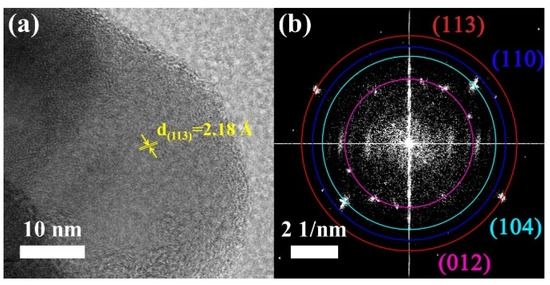
Figure 6.
(a) HRTEM map and (b) SAED diagram of the V2O3@CGL composites.
3. Discussion
GCD measurements were performed on the V2O3@CGL composite electrodes within the range 0.2–1.8 V at 0.05 A g−1. The resulting GCD profiles for the first five turns are presented in Figure 7a–c. The two pairs of redox voltage plateaus observed at 0.58/0.88 and 0.98/1.21 V on both the charge and discharge curves correspond to the CV curves below. The initial discharge specific capacity of the VOCG-2 composite electrode can be observed to reach 407.88 mAh g−1, which is considerably greater than that of VOCG-1 (307.64 mAh g−1) and VOCG-3 (357.43 mAh g−1). Although only V2O3 provides the specific capacity in the composites, a high proportion of V2O3 does not necessarily exhibit the highest specific capacity. This is due to the poor structural stability and intrinsic lack of electrical conductivity of V2O3. Therefore, the discharge specific capacity of V2O3 can be effectively optimized by the addition of an appropriate amount of CGL.
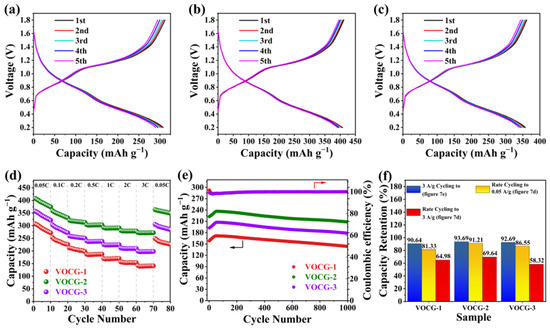
Figure 7.
GCD profiles of (a) VOCG-1, (b) VOCG-2, and (c) VOCG-3 composites in the original five cycles; (d) rate; (e) cycling properties; and (f) capacity retention after 1000 cycles at 3 A g−1 (blue), capacity retention after rate cycling to 3 A g−1 (yellow) and rate cycling back to 0.05 A g−1 (red) of the three samples.
Figure 7d illustrates the rate capability of the V2O3@CGL composite electrodes at varying current densities. The current density is incrementally raised from 0.05 C to 3 C and subsequently decreased to 0.05 C (specific multiplicity values are listed in Figure 7d). The discharge specific capacity exhibited a gradual decline as the current density increased. The average discharge specific capacities of VOCG-2 were 344.48, 316.61, 302.85, 290.84, 279.03, and 272.00 mAh g−1, respectively, which were significantly higher than those of VOCG-1 and VOCG-2. This indicates that VOCG-2 is superior in multiplicity performance. Upon the return of the current density to 0.05 C, the discharge specific capacity of VOCG-2 also recovered to 356.23 mAh g−1, which was 91.21% of the initial value. In contrast, the discharge specific capacity of VOCG-1 was only 81.33% (235.17 mAh g−1) and that of VOCG-3 was 86.55% (293.50 mAh g−1) of the initial value. The VOCG-1 and VOCG-2 electrodes exhibited a capacity of only 81.33% (235.17 mAh g−1) and 86.55% (293.50 mAh g−1) of the initial value, respectively. The aforementioned outcomes demonstrate that the VOCG-2 electrode exhibits excellent reversibility. Moreover, the crystal structure of the VOCG-2 electrode exhibits enhanced stability. The exceptional multiplicity performance of VOCG-2 may be attributed to the incorporation of CGL, which enhances the structural stability and conductivity of the electrode, facilitating the rapid (de)intercalation of carriers.
Figure 7e illustrates the cycling properties of the three V2O3@CGL composites at 3 A g−1. The capacities of all three composite electrodes exhibited a gradual increase over the initial 60 cycles, in agreement with vanadium-based materials reported in the literature, and may be related to the gradual electrochemical activation. The first discharge specific capacity of the VOCG-2 composite electrode was 222.41 mAh g−1, which was considerably superior to that of the VOCG-1 (158.32 mAh g−1) and VOCG-3 (192.55 mAh g−1) composite electrodes. After 56 cycles, the specific capacity of the VOCG-2 electrode reached a maximum of 236.71 mAh g−1. However, the maximum discharge specific capacities of the VOCG-1 and VOCG-3 composite electrodes were only 171.69 and 207.68 mAh g−1, respectively, after 53 and 58 cycles, which were significantly lower than that of the VOCG-2 electrode. Moreover, the reversible specific capacity of the VOCG-2 electrode was obtained at 208.38 mAh g−1 after 1000 cycles, with a capacity retention of 93.69%. In contrast, the specific capacities of the VOCG-1 and VOCG-3 electrodes were somewhat lower, at 143.51 mAh g−1 and 178.46 mAh g−1, respectively. Moreover, the capacity retentions were not as good as those of VOCG-2, at 90.65% and 92.67%, respectively. Consequently, the VOCG-2 electrode exhibits superior cycling stability. The exceptional electrochemical property of the VOCG-2 electrode is attributed to the CGL, which not only improves the electrode’s conductivity but also provides a well-developed pore structure that facilitates the diffusion of ions, thereby ensuring an optimal ion diffusion rate.
The CV curves were utilized to evaluate the electrochemical process kinetics of the V2O3@CGL electrode within the range 0.2–1.8 V, as depicted in Figure 8a. The three CV curves possess similar shapes, with two pairs of distinct coupled REDOX peaks placed at about 0.58/0.88 V and 0.98/1.21 V, respectively, indicating that the insertion of Zn2+ in the V2O3@CGL electrode undergoes a two-step reversible reaction, akin to the previously reported vanadium-based cathodes [6,16,34]. It has been reported that the area and current depicted in the CV curve are closely linked to the obtained capacity [44]. It is easily observed that the area of the VOCG-2 electrode is the largest, while the VOCG-1 electrode has the smallest area. Consequently, the VOCG-2 electrode has the largest specific capacity among them, while the VOCG-1 capacity is relatively lower.

Figure 8.
(a) CV curves of VOCG-1, VOCG-2, and VOCG-3 composites before and after cycling; (b) EIS spectra of the V2O3@CGL composite cathodes before and after cycling; and (c) GITT curve and corresponding DZn2+ values for the VOCG-2 composite cathode.
To further evaluate the charge transfer state of the V2O3@CGL composite electrodes, EIS measurements were carried out, and the corresponding Nyquist and EIS plots are depicted in Figure 8b. The three EIS curves exhibit a semicircle at medium-high frequencies and a straight line at low frequencies. The semicircle reflects charge transfer resistance (Rct), while the straight line is related to the ion diffusion process (Rs) within the electrode [45,46]. The equivalent circuit presented in Figure 8b was utilized for fitting, and the detailed fitting data are summarized in Table 2. Notably, the Rct values of the VOCG-2 composite electrode pre- and post-cycling were significantly lower than those of VOCG-1 and VOCG-3, indicating the superior electrical conductivity of the VOCG-2 electrode. Furthermore, the Rct values for all three V2O3@CGL electrodes after cycling are notably smaller compared to those before cycling, suggesting improved charge transfer kinetics following multiple cycles.

Table 2.
Electrochemical impedance spectra of the three V2O3@CGL composites before and after cycling.
To accurately investigate the diffusion kinetics of Zn2+ (DZn2+) in the VOCG-2 composite electrode, GITT measurements were performed, and DZn2+ was calculated using Formula (1):
where ΔEt is the change in voltage during the continuous current pulse after the iR drop has been removed and ΔEs is the change in steady-state potential owing to the current pulse. The electrode thickness is denoted as L, while the relaxation time is represented by τ. The GITT profile and the calculated DZn2+ values of the VOCG-2 composite electrode are depicted in Figure 8c. It can be observed that the DZn2+ values of the VOCG-2 composite electrode are in the range of 10−10.5 and 10−8 cm2 s−1 during cycling, which is a relatively good level. This indicates that Zn2+ has satisfactory diffusion kinetics in the VOCG-2 electrode, which is mainly associated with the natural porous structure of CGL, which can shorten the diffusion path for Zn2+ transport and promote its effective transport.
The morphological evolution of the VOCG-2 composite electrode in the pristine state and at different stages was investigated by SEM, as revealed in Figure 9a–f, respectively. The nanoparticles were evenly arranged on the stainless steel foil without agglomerating in their pristine state. After 200 and 400 cycles, the VOCG-2 composite electrode presented little morphological change, suggesting excellent structural stability during cycling. After 600 cycles, slight pulverization and agglomeration appeared on the surface of the VOCG-2 electrode. As charging and discharging continued, the pulverization and agglomeration were more pronounced (see Figure 9e,f), corresponding to the decrease in capacity in Figure 8e. Notably, no cracks or obvious dendrites appeared from the initial state to 1000 cycles (see Figure 9a–f), disclosing the protective mechanism of the array structure of the CGL. Therefore, the resulting VOCG-2 composite has good structural stability, which is advantageous for enhancing the cycle lifetime of AZIBs.
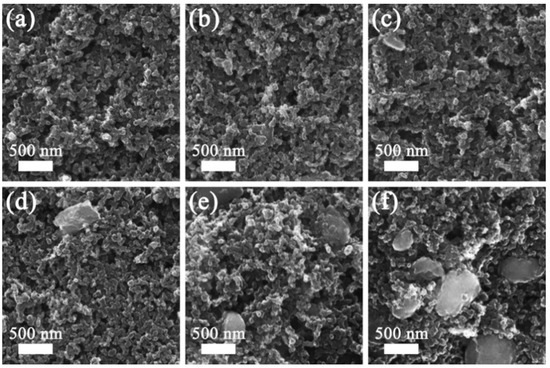
Figure 9.
SEM photographs of the VOCG-2 composite electrodes at various stages: (a) pristine, (b) 200, (c) 400, (d) 600, (e) 800, and (f) 1000 cycles.
Table 3 summarizes the electrochemical properties of several previously reported vanadium-based cathodes utilized for AZIB applications. The results reveal that the VOCG-2 composite proposed in this paper has certain advantages, and the desirable electrochemical properties of the VOCG-2 composite electrode can be correlated with the appropriate CGL content to increase the structural stability and electrical conductivity. Furthermore, the plentifully mesoporous structure and large specific surface area of CGL can facilitate the rapid storage of Zn2+.

Table 3.
Comparison of the electrochemical properties of the V2O3@CGL composite with other vanadium-based AZIB cathode materials that have been previously reported in the literature.
4. Experimental Section
4.1. Preparation of V2O3@CGL Composites
The Ganoderma lucidum was repeatedly cleaned with distilled water to remove soil, and placed in a drying oven at 60 °C until it was completely dry. The dried Ganoderma lucidum and KOH were mixed according to the mass ratio of 1:4 with deionized water as the ultrasonic solvent for two hours. It was then transferred to a blast drying oven maintained at 80 °C for the purpose of complete drying, followed by calcination at 600 °C for 2 h in argon to acquire Ganoderma lucidum biomass-derived carbon (CGL).
The detailed synthesis procedure for the V2O3@CGL composites is displayed in Figure 10. Firstly, 5.05 g CH4NO2 and 7.4 g NH4VO3 were dissolved in 100 mL of distilled water, followed by stirring in a water bath at 60 °C for 0.5 h. Subsequently, 40 mL of C2H6O2 solution and 0.3 g of CGL were mixed into the above solution, sealed, and left for a week. In order to completely evaporate the water, the mixture was dried in an oven at 80 °C for 48 h. The final stage of the process involved the transfer of the resulting precursors to a corundum crucible and their placement in a tubular furnace. Subsequently, the furnace was heated to 350 °C for 4 h and then heated to 800 °C for 8 h at a rate of 5 °C min−1 in an argon environment. This procedure yielded the desired VOCG-3 composite. The mass ratio of NH4VO3 to chestnut needle was adjusted in order to prepare the VOCG-1 and VOCG-2 composites by the same method. Table 4 illustrates the quality of the raw materials produced for each sample.

Figure 10.
The preparation process of the V2O3@CGL composites.

Table 4.
Summary of the dosage of raw materials synthesized from each sample.
4.2. Material Characterization
Detailed information on XRD, TGA, XPS, SEM, HRTEM, and FT-IR testing can be found in our previous paper: 10.3390/molecules28052147 [47]. The isothermal nitrogen adsorption/desorption test was conducted on the samples using an ASAP 2020 tester from Micromeritics, Norcross, GA, USA, maintained at 77 K beneath liquid nitrogen.
4.3. Electrochemical Measurements
In order to prepare the cathode, PVDF (10 w.t.%), acetylene black (20 w.t.%) and active material (70 w.t.%) were successively dispersed in N-methyl-2-pyrrolidone. The resulting mixed slurry was evenly coated on stainless steel foil and dried in a vacuum at 60 °C for 12 h. A CR2025 coin battery was assembled in air with glass fiber adopted as the diaphragm, 3 M ZnSO4 aqueous solution employed as the electrolyte, and commercial zinc foil utilized as the anode. For detailed information on partial electrochemical testing, please refer to our previous paper [47]. The galvanostatic intermittence titration technique (GITT) was carried out using the NETWARE test instrument within the range 0.2–1.8 V.
5. Conclusions
In this study, the V2O3@CGL composites were prepared using evaporation self-assembly technology with Ganoderma lucidum as the carbon source and NH4VO3 as the metal source. In these V2O3@CGL composites, CGL exhibits a porous structure and V2O3 provides large capacity, which can increase the electrolytic/cathodic contact area and provide incremental active sites. Moreover, the introduction of CGL increases the mechanical properties, while also making up for V2O3’s inadequate electrical conductivity. Thus, the V2O3@CGL composites possess the ideal electrochemical properties. Specifically, the VOCG-2 composite demonstrated superior initial discharge specific capacity and excellent cycle stability. Furthermore, SEM testing revealed that the VOCG-2 electrode microstructure remained stable without obvious cracks or zinc dendrites during cycling, which contributes to its excellent zinc storage properties. This research introduces an innovative strategy for the enhancement of the electrochemical properties of V2O3 and these results will assist in creating affordable high-performance vanadium-based AZlBs.
Author Contributions
Conceptualization, W.Z. and S.J.; methodology, G.Z.; software, G.Z.; validation, G.Z., W.Z. and S.J.; formal analysis, G.Z. and W.Z.; investigation, Z.L.; resources, W.Z.; data curation, Z.L.; writing—original draft preparation, G.Z.; writing—review and editing, W.Z.; visualization, S.J.; supervision, Z.L.; project administration, W.Z.; funding acquisition, W.Z. All authors have read and agreed to the published version of the manuscript.
Funding
The authors gratefully acknowledge the financial support of the Natural Science Foundation of Hunan Province (2022JJ50086).
Institutional Review Board Statement
Not applicable.
Informed Consent Statement
Not applicable.
Data Availability Statement
Data will be made available on request.
Conflicts of Interest
The authors declare no conflicts of interest.
References
- Shen, C.; Li, X.; Li, N.; Xie, K.; Wang, J.G.; Liu, X.; Wei, B. Graphene-Boosted, High-Performance Aqueous Zn-Ion Battery. ACS Appl. Mater. Interfaces 2018, 10, 25446–25453. [Google Scholar] [CrossRef] [PubMed]
- Fang, G.; Zhou, J.; Pan, A.; Liang, S. Recent Advances in Aqueous Zinc-Ion Batteries. ACS Energy Lett. 2018, 3, 2480–2501. [Google Scholar] [CrossRef]
- Konarov, A.; Voronina, N.; Jo, J.H.; Bakenov, Z.; Sun, Y.-K.; Myung, S.-T. Present and Future Perspective on Electrode Materials for Rechargeable Zinc-Ion Batteries. ACS Energy Lett. 2018, 3, 2620–2640. [Google Scholar] [CrossRef]
- Ming, F.; Liang, H.; Lei, Y.; Kandambeth, S.; Eddaoudi, M.; Alshareef, H.N. Layered MgxV2O5·nH2O as Cathode Material for High-Performance Aqueous Zinc Ion Batteries. ACS Energy Lett. 2018, 3, 2602–2609. [Google Scholar] [CrossRef]
- Yufit, V.; Tariq, F.; Eastwood, D.S.; Biton, M.; Wu, B.; Lee, P.D.; Brandon, N.P.J.J. Operando visualization and multi-scale tomography studies of dendrite formation and dissolution in zinc batteries. Joule 2019, 3, 485–502. [Google Scholar] [CrossRef]
- Chen, H.; Rong, Y.; Yang, Z.; Deng, L.; Wu, J. V2O3@Amorphous Carbon as a Cathode of Zinc Ion Batteries with High Stability and Long Cycling Life. Ind. Eng. Chem. Res. 2021, 60, 1517–1525. [Google Scholar] [CrossRef]
- Zhang, Y.; Xu, L.; Jiang, H.; Liu, Y.; Meng, C. Polyaniline-expanded the interlayer spacing of hydrated vanadium pentoxide by the interface-intercalation for aqueous rechargeable Zn-ion batteries. J. Colloid Interface Sci. 2021, 603, 641–650. [Google Scholar] [CrossRef] [PubMed]
- Niu, Y.; Wang, D.; Ma, Y.; Zhi, L. Cascading V2O3/N-doped carbon hybrid nanosheets as high-performance cathode materials for aqueous zinc-ion batteries. Chin. Chem. Lett. 2022, 33, 1430–1434. [Google Scholar] [CrossRef]
- Liu, Y.; Wang, T.; Sun, Y.; Zhang, M.; Gao, G.; Yang, J.; Cai, K. Fast and efficient in-situ construction of low crystalline PEDOT-intercalated V2O5 nanosheets for high-performance zinc-ion battery. Chem. Eng. J. 2024, 484, 149501. [Google Scholar] [CrossRef]
- Gao, Q.-L.; Li, D.-S.; Liu, X.-M.; Wang, Y.-F.; Liu, W.-L.; Ren, M.-M.; Kong, F.-G.; Wang, S.-J.; Zhou, R.-C. Biomass-derived mesoporous carbons materials coated by α-Mn3O4 with ultrafast zinc-ion diffusion ability as cathode for aqueous zinc ion batteries. Electrochim. Acta 2020, 335, 135642. [Google Scholar] [CrossRef]
- Tang, B.; Shan, L.; Liang, S.; Zhou, J. Issues and opportunities facing aqueous zinc-ion batteries. Energy Environ. Sci. 2019, 12, 3288–3304. [Google Scholar] [CrossRef]
- Lan, B.; Tang, C.; Chen, L.; Zhang, W.; Tang, W.; Zuo, C.; Fu, X.; Dong, S.; An, Q.; Luo, P. FeVO4⋅nH2O@rGO nanocomposite as high performance cathode materials for aqueous Zn-ion batteries. J. Alloys Compd. 2020, 818, 153372. [Google Scholar] [CrossRef]
- Zhang, W.; Xiao, Y.; Zuo, C.; Tang, W.; Liu, G.; Wang, S.; Cai, W.; Dong, S.; Luo, P. Adjusting the Valence State of Vanadium in VO2(B) by Extracting Oxygen Anions for High-Performance Aqueous Zinc-Ion Batteries. ChemSusChem 2020, 14, 971–978. [Google Scholar] [CrossRef] [PubMed]
- Kidanu, W.G.; Hur, J.; Choi, H.W.; Kim, M.I.; Kim, I.T. High capacity and inexpensive multivalent cathode materials for aqueous rechargeable Zn-ion battery fabricated via in situ electrochemical oxidation of VO2 nanorods. J. Power Sources 2022, 523, 231060. [Google Scholar] [CrossRef]
- Liu, Y.; Hu, P.; Liu, H.; Wu, X.; Zhi, C. Tetragonal VO2 hollow nanospheres as robust cathode material for aqueous zinc ion batteries. Mater. Today Energy 2020, 17, 100431. [Google Scholar] [CrossRef]
- Liu, Y.; Liu, Y.; Wu, X.; Cho, Y.-R. Enhanced Electrochemical Performance of Zn/VOx Batteries by a Carbon-Encapsulation Strategy. ACS Appl. Mater. Interfaces 2022, 14, 11654–11662. [Google Scholar] [CrossRef] [PubMed]
- Lv, T.-T.; Luo, X.; Yuan, G.-Q.; Yang, S.-Y.; Pang, H. Layered VO2@N-doped carbon composites for high-performance rechargeable aqueous zinc-ion batteries. Chem. Eng. J. 2022, 428, 131211. [Google Scholar] [CrossRef]
- Ding, Y.; Peng, Y.; Chen, W.; Niu, Y.; Wu, S.; Zhang, X.; Hu, L. V-MOF derived porous V2O5 nanoplates for high performance aqueous zinc ion battery. Appl. Surf. Sci. 2019, 493, 368–374. [Google Scholar] [CrossRef]
- Hu, P.; Zhu, T.; Wang, X.; Wei, X.; Yan, M.; Li, J.; Luo, W.; Yang, W.; Zhang, W.; Zhou, L.; et al. Highly durable Na2V6O16·1.63H2O nanowire cathode for aqueous zinc-ion battery. Nano Lett. 2018, 18, 1758–1763. [Google Scholar] [CrossRef] [PubMed]
- Hei, J.; Cheng, L.; Fu, Y.; Du, W.; Qian, Y.; Li, J.; Yin, Y.; Wang, N.; Su, L.; Wang, L. Uniformly confined V2O3 quantum dots embedded in biomass derived mesoporous carbon toward fast and stable energy storage. Ceram. Int. 2023, 49, 16002–16010. [Google Scholar] [CrossRef]
- He, Z.; Cheng, G.; Jiang, Y.; Li, Y.; Zhu, J.; Meng, W.; Zhou, H.; Dai, L.; Wang, L. Novel 2D porous carbon nanosheet derived from biomass: Ultrahigh porosity and excellent performances toward V2+/V3+ redox reaction for vanadium redox flow battery. Int. J. Hydrogen Energy 2020, 45, 3959–3970. [Google Scholar] [CrossRef]
- Li, Y.; Lin, W.; Xue, L.; Xie, J.; Wei, B.; Chen, G.; Chen, D. Facile preparation of V2O3/black fungus-derived carbon composite with hierarchical porosity as a promising electrode for lithium/sodium ion batteries. J. Alloys Compd. 2022, 905, 164258. [Google Scholar] [CrossRef]
- Doǧan, H.; Taş, M.; Meşeli, T.; Elden, G.; Genc, G. Review on the Applications of Biomass-Derived Carbon Materials in Vanadium Redox Flow Batteries. ACS Omega 2023, 8, 34310–34327. [Google Scholar] [CrossRef] [PubMed]
- Zhai, M.; Ye, J.; Jiang, Y.; Yuan, S.; Li, Y.; Liu, Y.; Dai, L.; Wang, L.; He, Z. Biomass-derived carbon materials for vanadium redox flow battery: From structure to property. J. Colloid Interface Sci. 2023, 651, 902–918. [Google Scholar] [CrossRef] [PubMed]
- Hu, J.; Xie, Y.; Zheng, J.; Li, H.; Wang, T.; Lai, Y.; Zhang, Z. Encapsulating V2O3 Nanoparticles in Hierarchical Porous Carbon Nanosheets via C–O–V Bonds for Fast and Durable Potassium-Ion Storage. ACS Appl. Mater. Interfaces 2021, 13, 12149–12158. [Google Scholar] [CrossRef] [PubMed]
- Henry, A.; Hesemann, P.; Alauzun, J.G.; Boury, B. Reductive mineralization of cellulose with vanadium, iron and tungsten chlorides and access to MxOy metal oxides and MxOy/C metal oxide/carbon composites. Carbohydr. Polym. 2017, 174, 697–705. [Google Scholar] [CrossRef] [PubMed]
- Zheng, J.; Zhang, Y.; Jing, X.; Liu, X.; Hu, T.; Lv, T.; Zhang, S.; Meng, C. Synthesis of amorphous carbon coated on V2O3 core-shell composites for enhancing the electrochemical properties of V2O3 as supercapacitor electrode. Colloids Surf. A Physicochem. Eng. Asp. 2017, 518, 188–196. [Google Scholar] [CrossRef]
- Feng, Z.; Zhang, Y.; Yu, X.; Yu, Y.; Huang, C.; Meng, C. Aluminum-ion intercalation and reduced graphene oxide wrapping enable the electrochemical properties of hydrated V2O5 for Zn-ion storage. Colloids Surf. A Physicochem. Eng. Asp. 2022, 641, 128473. [Google Scholar] [CrossRef]
- Liu, Y.; Pan, Z.; Tian, D.; Hu, T.; Jiang, H.; Yang, J.; Sun, J.; Zheng, J.; Meng, C.; Zhang, Y. Employing “one for two” strategy to design polyaniline-intercalated hydrated vanadium oxide with expanded interlayer spacing for high-performance aqueous zinc-ion batteries. Chem. Eng. J. 2020, 399, 125842. [Google Scholar] [CrossRef]
- Ouyang, D.; Wang, C.; Yang, L.; Zhang, Y.; Wang, Y.-N.; Zhu, H.; Yu, F.; Yin, J. Enhancing Potassium Storage Performance in VO2/V2O3@C Nanosheets by Synergistic Effect of Oxygen Vacancy and C-O-V Bond. ChemElectroChem 2022, 9, e202200639. [Google Scholar] [CrossRef]
- Hu, T.; Liu, Y.; Zhang, Y.; Nie, Y.; Zheng, J.; Wang, Q.; Jiang, H.; Meng, C. Encapsulating V2O3 nanorods into carbon core-shell composites with porous structures and large specific surface area for high performance solid-state supercapacitors. Microporous Mesoporous Mater. 2018, 262, 199–206. [Google Scholar] [CrossRef]
- Gou, W.; Kong, X.; Wang, Y.; Ai, Y.; Liang, S.; Pan, A.; Cao, G. Yolk-shell structured V2O3 microspheres wrapped in N, S co-doped carbon as pea-pod nanofibers for high-capacity lithium ion batteries. Chem. Eng. J. 2019, 374, 545–553. [Google Scholar] [CrossRef]
- Kim, J.-H.; Kim, Y.-S.; Moon, S.-H.; Park, D.-H.; Kim, M.-C.; Choi, J.-H.; Shin, J.-H.; Park, K.-W. Enhanced electrochemical performance of a selectively formed V2O3/C composite structure for Li-ion batteries. Electrochim. Acta 2021, 389, 138685. [Google Scholar] [CrossRef]
- Deng, L.; Chen, H.; Wu, J.; Yang, Z.; Rong, Y.; Fu, Z. V2O3 as cathode of zinc ion battery with high stability and long cycling life. Ionics 2021, 27, 3393–3402. [Google Scholar] [CrossRef]
- Liu, X.; Wang, Z.; Niu, Y.; Liu, C.; Chen, H.; Ren, X.; Wang, M.; Lau, W.-M.; Zhou, D. Scalable synthesis of novel V2O3/carbon composite as advanced cathode material for aqueous zinc-ion batteries. Ceram. Int. 2022, 48, 15594–15602. [Google Scholar] [CrossRef]
- Liu, C.L.; Liu, Y.; Liu, X.; Gong, Y. Coordination polymer-derived Al3+-doped V2O3/C with rich oxygen vacancies for an advanced aqueous zinc-ion battery with ultrahigh rate capability. Sustain. Energy Fuels 2022, 6, 2020–2037. [Google Scholar] [CrossRef]
- Wang, J.; Li, G.; Liu, X.; Ouyang, Q.; Ma, M.; Wang, Q.; Zhang, X.; Fan, Z.; Li, L. In-situ electrochemical oxidization of V2O3-C cathode for boosted zinc-ion storage performance. Appl. Surf. Sci. 2023, 616, 156481. [Google Scholar] [CrossRef]
- Wang, Q.; Feng, Q.; Lei, Y.; Tang, S.; Xu, L.; Xiong, Y.; Fang, G.; Wang, Y.; Yang, P.; Liu, J.; et al. Quasi-solid-state Zn-air batteries with an atomically dispersed cobalt electrocatalyst and organohydrogel electrolyte. Nat. Commun. 2022, 13, 3689. [Google Scholar] [CrossRef] [PubMed]
- Liu, X.; Wang, Z.; Niu, Y.; Liu, C.; Chen, H.; Ren, X.; Liu, Z.; Lau, W.-M.; Zhou, D. Electrospun V2O3@Carbon Nanofibers as a Flexible and Binder-Free Cathode for Highly Stable Aqueous Zn-Ion Full Batteries. ACS Appl. Energy Mater. 2022, 5, 3525–3535. [Google Scholar] [CrossRef]
- Zhang, H.; Zhang, Y.; Liu, Y.; Shi, X.; Zhang, Y.; Bai, L.; Wang, Q.; Sun, L. Oxygen-Deficient α-MnO2 Nanotube/Graphene/N, P Codoped Porous Carbon Composite Cathode To Achieve High-Performing Zinc-Ion Batteries. ACS Appl. Mater. Interfaces 2022, 14, 36668–36678. [Google Scholar] [CrossRef] [PubMed]
- Zhao, J.; Zhao, Y.; Yue, W.-C.; Li, X.; Gao, N.; Zhang, Y.-J.; Hu, C.-Q. V2O3/VN Catalysts Decorated Free-Standing Multifunctional Interlayer for High-Performance Li-S Battery. Chem. Eng. J. 2022, 441, 136082. [Google Scholar] [CrossRef]
- Chen, H.; Wang, Y.; Liu, C.; Hou, L.; Sun, J.; Yuan, C. Two-dimensional V2CTx In-situ Derived Porous V2O3@C Flakes Towards Zinc-Ion Capacitors as a Competitive Cathode Material. ChemNanoMat 2022, 9, e202200394. [Google Scholar] [CrossRef]
- Zhang, H.; Yao, Z.; Lan, D.; Liu, Y.; Ma, L.; Cui, J. N-doped carbon/V2O3 microfibers as high-rate and ultralong-life cathode for rechargeable aqueous zinc-ion batteries. J. Alloys Compd. 2021, 861, 158560. [Google Scholar] [CrossRef]
- Shin, J.; Jung, H.; Kim, Y.; Kim, J. Carbon-coated V2O5 nanoparticles with enhanced electrochemical performance as a cathode material for lithium ion batteries. J. Alloys Compd. 2014, 589, 322–329. [Google Scholar] [CrossRef]
- Duan, Y.; Geng, Z.; Zhang, D.; Wang, Q. In situ electrochemically activated V2O3@MXene cathode for a super high-rate and long-life Zn-ion battery. Dalton Trans. 2024, 53, 7023–7034. [Google Scholar] [CrossRef] [PubMed]
- Yin, C.; Wang, H.; Pan, C.; Li, Z.; Hu, J. Constructing MOF-derived V2O5 as advanced cathodes for aqueous zinc ion batteries. J. Energy Storage 2023, 73, 109045. [Google Scholar] [CrossRef]
- Zhou, W.; Zeng, G.; Jin, H.; Jiang, S.; Huang, M.; Zhang, C.; Chen, H. Bio-Template Synthesis of V2O3@Carbonized Dictyophora Composites for Advanced Aqueous Zinc-Ion Batteries. Molecules 2023, 28, 2147. [Google Scholar] [CrossRef] [PubMed]
- Zeng, G.; Wang, Y.; Lou, X.; Chen, H.; Jiang, S.; Zhou, W. Vanadium oxide/carbonized chestnut needle composites as cathode materials for advanced aqueous zinc-ion batteries. J. Energy Storage 2024, 77, 109859. [Google Scholar] [CrossRef]
- Wu, T.-H.; Li, Y.-M.; Ni, K.-Y.; Li, T.-K.; Lin, W.-S. Vanadium oxides obtained by chimie douce reactions: The influences of transition metal species on crystal structures and electrochemical behaviors in zinc–ion batteries. J. Colloid Interface Sci. 2022, 608, 3121–3129. [Google Scholar] [CrossRef] [PubMed]
- Xu, L.; Zhang, Y.; Zheng, J.; Jiang, H.; Hu, T.; Meng, C. Ammonium ion intercalated hydrated vanadium pentoxide for advanced aqueous rechargeable Zn-ion batteries. Mater. Today Energy 2020, 18, 100509. [Google Scholar] [CrossRef]
- Venkatkarthick, R.; Rodthongkum, N.; Zhang, X.; Wang, S.; Pattananuwat, P.; Zhao, Y.; Liu, R.; Qin, J. Vanadium-Based Oxide on Two-Dimensional Vanadium Carbide MXene (V2Ox@V2CTx) as Cathode for Rechargeable Aqueous Zinc-Ion Batteries. ACS Appl. Energy Mater. 2020, 3, 4677–4689. [Google Scholar] [CrossRef]
- Hu, J.; Chen, H.; Xiang, K.; Xiao, L.; Chen, W.; Liao, H.; Chen, H. Preparation for V6O13@hollow carbon microspheres and their remarkable electrochemical performance for aqueous zinc-ion batteries. J. Alloys Compd. 2021, 856, 157085. [Google Scholar] [CrossRef]
- Bin, D.; Wang, Y.; Tamirat, A.G.; Zhu, P.; Yang, B.; Wang, J.; Huang, J.; Xia, Y. Stable High-Voltage Aqueous Zinc Battery Based on Carbon-Coated NaVPO4F Cathode. ACS Sustain. Chem. Eng. 2021, 9, 3223–3231. [Google Scholar] [CrossRef]
- Hong, J.; Xie, L.; Shi, C.; Lu, X.; Shi, X.; Cai, J.; Wu, Y.; Shao, L.; Sun, Z. High-Performance Aqueous Zinc-Ion Batteries Based on Multidimensional V2O3 Nanosheets@Single-Walled Carbon Nanohorns@Reduced Graphene Oxide Composite and Optimized Electrolyte. Small Methods 2024, 8, 2300205. [Google Scholar] [CrossRef] [PubMed]
- Pan, D.; Liu, T.; Fu, J.; Liu, H. Superior electrochemical performance of dual-monoclinic δ-NaxV2O5/VO2(B) composite material with enhanced synergistic effects. J. Alloys Compd. 2022, 926, 166952. [Google Scholar] [CrossRef]
Disclaimer/Publisher’s Note: The statements, opinions and data contained in all publications are solely those of the individual author(s) and contributor(s) and not of MDPI and/or the editor(s). MDPI and/or the editor(s) disclaim responsibility for any injury to people or property resulting from any ideas, methods, instructions or products referred to in the content. |
© 2024 by the authors. Licensee MDPI, Basel, Switzerland. This article is an open access article distributed under the terms and conditions of the Creative Commons Attribution (CC BY) license (https://creativecommons.org/licenses/by/4.0/).